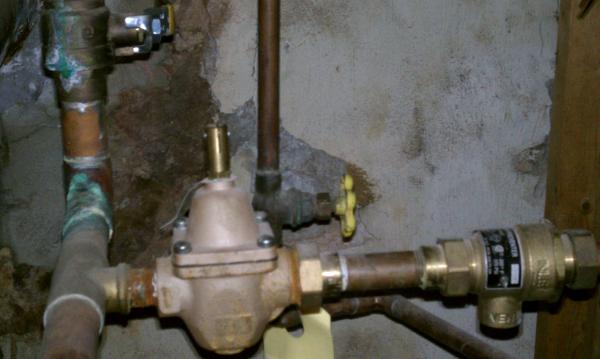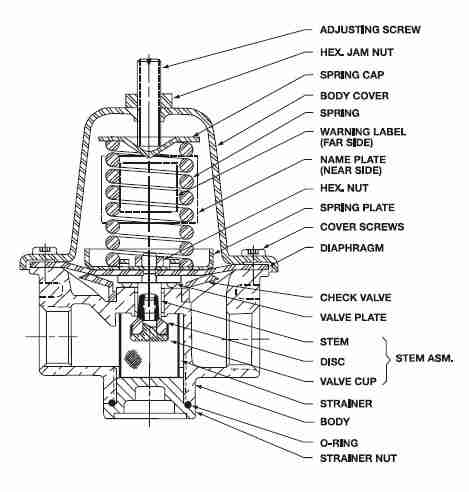Find the auto-fill valve (sometimes called a pressure reducing valve. It looks something like this:

On the top stem there is an adjustment screw and a flip-lever for over-riding the pressure control setting to fill the system quickly. There is also going to be a ball valve (3-4" long lever handle) or a gate valve (like the yellow handled valve in the above picture) to isolate the potable water supply.
Turn off the isolating valve, then put a bucket under the outlet down tube of your boiler's pressure relief valve (your top picture), and flip up the lever on the pressure reducing valve to run water into the bucket. Keep an eye on the pressure gauge, and stop the flow when the pressure reaches ~12psi.
Then loosen the locking hex nut on the stem of the auto-fill valve so that it can be adjusted, and crack open the isolating valve between the potable plumbing & auto-fill valve slightly. If you hear water flowing, adjust the screw on the auto-fill until it stops. Check the system pressure- if it's still 12-15 psi you're good to go- open the isolating valve all the way, and you shouldn't hear any more flow. If it's over 15psi you may have to close the isolating valve and bleed off some water to lower the pressure and repeat the pressure adjustment until you get it in the range. (Don't set it very much lower than 12 psi or you may begin to hear flash-boil knocking every time the thing fires up.) With the pressure adjusted, cinch down the lock nut a bit so that the pressure adjustment doesn't change over time.

Keep an eye on the system pressure for a few days/weeks. If the seat to the auto fill valve is worn or has a bit of trapped grit in it there may be water seeping by, slowly overfilling the heating system. If that's the case the auto-fill valve should then be replaced, but if the isolating valve seals well you can get by with it for a long time by just keeping the isloating valve closed.

On the top stem there is an adjustment screw and a flip-lever for over-riding the pressure control setting to fill the system quickly. There is also going to be a ball valve (3-4" long lever handle) or a gate valve (like the yellow handled valve in the above picture) to isolate the potable water supply.
Turn off the isolating valve, then put a bucket under the outlet down tube of your boiler's pressure relief valve (your top picture), and flip up the lever on the pressure reducing valve to run water into the bucket. Keep an eye on the pressure gauge, and stop the flow when the pressure reaches ~12psi.
Then loosen the locking hex nut on the stem of the auto-fill valve so that it can be adjusted, and crack open the isolating valve between the potable plumbing & auto-fill valve slightly. If you hear water flowing, adjust the screw on the auto-fill until it stops. Check the system pressure- if it's still 12-15 psi you're good to go- open the isolating valve all the way, and you shouldn't hear any more flow. If it's over 15psi you may have to close the isolating valve and bleed off some water to lower the pressure and repeat the pressure adjustment until you get it in the range. (Don't set it very much lower than 12 psi or you may begin to hear flash-boil knocking every time the thing fires up.) With the pressure adjusted, cinch down the lock nut a bit so that the pressure adjustment doesn't change over time.

Keep an eye on the system pressure for a few days/weeks. If the seat to the auto fill valve is worn or has a bit of trapped grit in it there may be water seeping by, slowly overfilling the heating system. If that's the case the auto-fill valve should then be replaced, but if the isolating valve seals well you can get by with it for a long time by just keeping the isloating valve closed.
